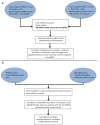Prognostic microRNAs in high-grade glioma reveal a link to oligodendrocyte precursor differentiation
- PMID: 25897422
- PMCID: PMC4394131
- DOI: 10.18632/oncoscience.112
Prognostic microRNAs in high-grade glioma reveal a link to oligodendrocyte precursor differentiation
Abstract
MicroRNA expression can be exploited to define tumor prognosis and stratification for precision medicine. It remains unclear whether prognostic microRNA signatures are exclusively tumor grade and/or molecular subtype-specific, or whether common signatures of aggressive clinical behavior can be identified. Here, we defined microRNAs that are associated with good and poor prognosis in grade III and IV gliomas using data from The Cancer Genome Atlas. Pathway analysis of microRNA targets that are differentially expressed in good and poor prognosis glioma identified a link to oligodendrocyte development. Notably, a microRNA expression profile that is characteristic of a specific oligodendrocyte precursor cell type (OP1) correlates with microRNA expression from 597 of these tumors and is consistently associated with poor patient outcome in grade III and IV gliomas. Our study reveals grade-independent and subtype-independent prognostic molecular signatures in high-grade glioma and provides a framework for investigating the mechanisms of brain tumor aggressiveness.
Keywords: astrocytoma; glioblastoma; glioma; microRNA; oligodendrocyte; prognosis.
Conflict of interest statement
The authors have no conflicts of interest to declare.
Figures




Similar articles
-
Identification of low miR-105 expression as a novel poor prognostic predictor for human glioma.Int J Clin Exp Med. 2015 Jul 15;8(7):10855-64. eCollection 2015. Int J Clin Exp Med. 2015. PMID: 26379879 Free PMC article.
-
MicroRNA-210 overexpression predicts poorer prognosis in glioma patients.J Clin Neurosci. 2014 May;21(5):755-60. doi: 10.1016/j.jocn.2013.06.024. Epub 2013 Sep 11. J Clin Neurosci. 2014. PMID: 24382515
-
Up-regulation of microRNA-15b correlates with unfavorable prognosis and malignant progression of human glioma.Int J Clin Exp Pathol. 2015 May 1;8(5):4943-52. eCollection 2015. Int J Clin Exp Pathol. 2015. PMID: 26191187 Free PMC article.
-
Overview of prognostic factors in adult gliomas.Ann Palliat Med. 2021 Jan;10(1):863-874. doi: 10.21037/apm-20-640. Epub 2020 Aug 7. Ann Palliat Med. 2021. PMID: 32787379 Review.
-
Molecular biology of malignant gliomas.Clin Transl Oncol. 2006 Sep;8(9):635-41. doi: 10.1007/s12094-006-0033-9. Clin Transl Oncol. 2006. PMID: 17005465 Review.
Cited by
-
P68 RNA helicase promotes invasion of glioma cells through negatively regulating DUSP5.Cancer Sci. 2019 Jan;110(1):107-117. doi: 10.1111/cas.13858. Epub 2018 Dec 3. Cancer Sci. 2019. PMID: 30387548 Free PMC article.
-
Inhibitory effect of miR-184 on the potential of proliferation and invasion in human glioma and breast cancer cells in vitro.Int J Clin Exp Pathol. 2015 Aug 1;8(8):9376-82. eCollection 2015. Int J Clin Exp Pathol. 2015. PMID: 26464691 Free PMC article.
-
Evaluation of rat C6 malignant glioma using spectral computed tomography.Exp Ther Med. 2017 Aug;14(2):1037-1044. doi: 10.3892/etm.2017.4613. Epub 2017 Jun 15. Exp Ther Med. 2017. PMID: 28810555 Free PMC article.
-
MicroRNA expression and its implications for diagnosis and therapy of gallbladder cancer.Oncotarget. 2015 Jun 10;6(16):13914-21. doi: 10.18632/oncotarget.4227. Oncotarget. 2015. PMID: 26040010 Free PMC article. Review.
-
Fragile X mental retardation protein promotes astrocytoma proliferation via the MEK/ERK signaling pathway.Oncotarget. 2016 Nov 15;7(46):75394-75406. doi: 10.18632/oncotarget.12215. Oncotarget. 2016. PMID: 27683117 Free PMC article.
References
Grants and funding
LinkOut - more resources
Full Text Sources
Other Literature Sources

